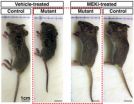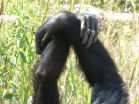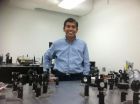(Press-News.org) KANSAS CITY, MO—As the national waistline expands, so do pools of intra-cellular fat known as lipid droplets. Although most of us wish our lipid droplets would vanish, they represent a cellular paradox: on the one hand droplets play beneficial roles by corralling fat into non-toxic organelles. On the other, oversized lipid droplets are associated with obesity and its associated health hazards.
Until recently researchers understood little about factors that regulate lipid droplet size. Now, a study from the Stowers Institute of Medical Research published in an upcoming issue of Journal of Cell Biology reports a genetic screen of roundworms that identifies two proteins required for the dramatic expansion of lipid droplets. That study, from the lab of Assistant Investigator Ho Yi Mak, Ph.D., sheds new light onto the molecular processes linked to fat metabolism.
"In worms and mammals lipid droplets are evolutionarily conserved structures that store cellular fat as triglycerides, a benign form of fat," says Mak, whose lab relies heavily on the roundworm C. elegans to evaluate the genetics and biochemistry of fat storage. "Currently, there is a great appreciation that a diverse range of systems can be exploited to understand where triglycerides are synthesized and how they get stored in lipid droplets."
Prior to the Journal of Cell Biology study, Mak's lab and others had shown that some enzymes that direct triglyceride synthesis are physically located in a network of intracellular tubules called the endoplasmic reticulum (ER), suggesting that the ER communicates with lipid droplets. In fact, high magnification imaging of single cells showed that ER membranes often "push up" against droplets, suggesting they might in some way load them.
To determine if this was the case, the Mak team employed mutant roundworms they previously discovered that displayed abnormally large-sized lipid droplets. Using genetic techniques, Mak introduced additional mutations in the genome of these worms to search for hits that restored droplets to normal size.
That effort revealed that disruption of two genes that encode proteins named FATP1 and DGAT2 did just that: hits in either shrank fat droplets to normal size. Further biochemical analysis showed that FATP1 and DGAT2, which catalyze sequential steps in triglyceride synthesis, were closely associated in a protein complex, strongly suggesting that they act in a two-step process required to form out-sized droplets in the first place.
Most interestingly, both FATP1 and DGAT2 resided in the right cellular space: imaging of living worms revealed that FATP1 resides in ER membranes, while DGAT2 is enriched at the surface of the droplets, suggesting an anatomical link between the two enzymes regulating triglyceride biosynthesis.
Finally, the team demonstrated the relevance of this mechanism to mammalian cells by expressing mouse versions of FATP1 and DGAT2 in cultured cells. They then added a fatty acid building block of triglycerides to the culture media—the equivalent of feeding cells a pizza—and monitored fat storage.
"What we saw was that again the two proteins were in close proximity to each other in cells and acted synergistically to allow cells to store more fat and expand the size of lipid droplets," says Mak. "This shows that coupling of FATP1 and DGAT2 seen in worms is evolutionarily conserved in mammalian cells."
Mak cautions that no one should assume that simply inactivating FATP1 and DGAT2 could be a panacea to weight gain: apparently, there is one thing worse than having an oversized fat droplet, and that's not being able to form one at all. "One side of this issue suggests that lipid droplet formation is actually protective," he says, noting that failure to sequester fat into droplets can cause cellular stress and insulin resistance. "By the time you see large lipid droplets, tissues are trying very hard to contain the harmful effects of excess fat."
Thus, although out-sized lipid droplets are often observed in liver and muscle cells of obese individuals, the toxic conditions that trigger obesity-related conditions like diabetes may emerge when fat depots can no longer expand.
On the flip side, Mak notes that endurance athletes also display oversized lipid droplets in muscle cells. "Lipid droplets store a rich form of energy," he says. "Having a high energy depot on site likely allows muscle tissues use them as a sustained form of energy."
Mak's team will now address whether nutrient intake regulates FATP1-DGAT2 activity and hence droplet size. "Right now the worm is our primary discovery tool," he says. "But we will continue to extend our studies to mammalian cell culture models. We want to know whether the FATP1-DGAT2 complex becomes more active after you eat a Big Mac or a piece of apple pie."
INFORMATION:
The study's first author was Ningyi Xu, a postdoctoral fellow in the Mak lab. Also contributing to the study were Shaobing O. Zhang, Ronald
A. Cole, Sean A. McKinney, Fengli Guo, and Sudheer Bobba—all of the Stowers Institute—and Robert V. Farese, Jr., and Joel T. Haas, both of the University of California, San Francisco.
The work was supported by funding from the Stowers Institute for Medical Research and the National Institutes of Health.
About the Stowers Institute for Medical Research
The Stowers Institute for Medical Research is a non-profit, basic biomedical research organization dedicated to improving human health by studying the fundamental processes of life. Jim Stowers, founder of American Century Investments, and his wife, Virginia, opened the Institute in 2000. Since then, the Institute has spent over 900 million dollars in pursuit of its mission.
Currently, the Institute is home to nearly 550 researchers and support personnel; over 20 independent research programs; and more than a dozen technology-development and core facilities.
Oversized fat droplets: Too much of a good thing
Stowers investigators define factors that regulate size of cellular fat pools
2012-08-29
ELSE PRESS RELEASES FROM THIS DATE:
Climate change could increase levels of avian influenza in wild birds
2012-08-29
ANN ARBOR, Mich.—Rising sea levels, melting glaciers, more intense rainstorms and more frequent heat waves are among the planetary woes that may come to mind when climate change is mentioned. Now, two University of Michigan researchers say an increased risk of avian influenza transmission in wild birds can be added to the list.
Population ecologists Pejman Rohani and Victoria Brown used a mathematical model to explore the consequences of altered interactions between an important species of migratory shorebird and horseshoe crabs at Delaware Bay as a result of climate ...
ESC analysis reveals arrhythmia treatment gaps between Eastern and Western Europe
2012-08-29
The analysis was conducted using five editions of the EHRA White Book, which is produced by the European Heart Rhythm Association (EHRA), a registered branch of the European Society of Cardiology (ESC).
The EHRA White Book reports on the current status of arrhythmia treatments in the 54 ESC member countries and has been published every year since 2008. Data is primarily provided by the national cardiology societies and working groups of cardiac pacing and electrophysiology of each ESC country. Prospective data is collected on catheter ablation and on implantation of cardiovascular ...
TAVI restricted to very old or very sick patients
2012-08-29
The registry is part of the European Society of Cardiology (ESC) EURObservational Research Programme (EORP) of surveys and registries.
Today's presentation reveals current usage of the most modern TAVI valves and catheters in Europe, and compares indications, techniques and outcomes between different countries. "TAVI is a new technology which has been introduced in Europe but many question marks remain on which patients are most suitable," said Professor Di Mario. "We set up this registry because it was important to have a clear picture of clinical practice in Europe. ...
Added benefit of fampridine is not proven
2012-08-29
Fampridine (trade name Fampyra®) has been approved in Germany since July 2011 for adult patients suffering from a higher grade walking disability (grades 4 to 7 on the EDSS disability status scale), as a result of multiple sclerosis (MS). The German Institute for Quality and Efficiency in Health Care (IQWiG) has assessed the added benefit of the drug pursuant to the Act on the Reform of the Market for Medicinal Products (AMNOG). According to the findings, there is no proof of added benefit, as the manufacturer's dossier contains no evaluable study data for the comparison ...
Could a cancer drug potentially prevent learning disabilities in some kids?
2012-08-29
ANN ARBOR, Mich. — A drug originally developed to stop cancerous tumors may hold the potential to prevent abnormal brain cell growth and learning disabilities in some children, if they can be diagnosed early enough, a new animal study suggests.
The surprising finding sets the stage for more research on how anti-tumor medication might be used to protect the developing brains of young children with the genetic disease neurofibromatosis 1 -- and other diseases affecting the same cellular signaling pathway.
The findings, made in mice, are reported in the journal Cell ...
Belimumab for lupus erythematosus: Added benefit not proven
2012-08-29
Belimumab (trade name Benlysta ®) has been approved since July 2011 as an add-on therapy for adult patients with the autoimmune disease systemic lupus erythematosus (SLE). This monoclonal antibody is only considered as treatment when the disease is still active in spite of standard therapy. The German Institute for Quality and Efficiency in Health Care (IQWiG) has now examined the added benefit of this drug pursuant to the Act on the Reform of the Market for Medicinal Products (AMNOG).
According to the findings, there is no proof that belimumab provides added benefit ...
Mount Sinai researchers solve mystery surrounding the death of two sisters nearly 50 years ago
2012-08-29
Researchers at Mount Sinai School of Medicine have identified the genetic cause of a rare and fatal bone disease by studying frozen skin cells that were taken from a child with the condition almost fifty years ago. Their study, which details how the MT1-MMP gene leads to the disease known as Winchester syndrome, appears in the August 23, 2012 online edition of The American Journal of Human Genetics.
In 1969, Patricia Winchester, MD, a pediatric radiologist in New York City, was asked to diagnose two young sisters who were losing bone in their hands and feet, developing ...
Biomass characterization technology research highlighted in Industrial Biotechnology journal
2012-08-29
New Rochelle, NY, August 29, 2012--Biomass recalcitrance--the problem of how to break down complex plant-based cellulosic feedstock into sugars that can be fermented to produce sustainable biofuels and other renewable biobased products—can be overcome through improved methods of biomass characterization. IB IN-DEPTH, a collection of articles from leading research laboratories describing advanced tools and techniques for analyzing the chemistry, structure, and interaction of biomass components, is published in Industrial Biotechnology, a peer-reviewed journal from Mary Ann ...
Chimpanzees create social traditions
2012-08-29
A research collaboration between the Gonzaga University and the Max Planck Institute shows that the way in which chimpanzees groom each other depends on the community to which they belong. Specifically, it is the unique handclasp grooming behaviour that reveals this local difference.
The specific behaviour that the researchers focused on was the 'grooming handclasp', a behaviour where two chimpanzees clasp onto each other's arms, raise those arms up in the air, and groom each other with their free arm. This behaviour has only been observed in some chimpanzee populations. ...
Breakthrough in nanotechnology
2012-08-29
A University of Central Florida assistant professor has developed a new material using nanotechnology, which could help keep pilots and sensitive equipment safe from destructive lasers.
UCF Assistant Professor Jayan Thomas, in collaboration with Carnegie Mellon University Associate Professor Rongchao Jin chronicle their work in the July issue of the journal Nano Letters. (http://dx.doi.org/10.1021/nl301988v)
Thomas is working with gold nanoparticles and studying their properties when they are shrunk into a small size regime called nanoclusters. Nanoparticles are already ...
LAST 30 PRESS RELEASES:
Switching immune cells to “night mode” could limit damage after a heart attack, study suggests
URI-based Global RIghts Project report spotlights continued troubling trends in worldwide inhumane treatment
Neutrophils are less aggressive at night, explaining why nighttime heart attacks cause less damage than daytime events
Menopausal hormone therapy may not pose breast cancer risk for women with BRCA mutations
Mobile health tool may improve quality of life for adolescent and young adult breast cancer survivors
Acupuncture may help improve perceived breast cancer-related cognitive difficulties over usual care
Nerve block may reduce opioid use in infants undergoing cleft palate surgery
CRISPR primes goldenberry for fruit bowl fame
Mass General Brigham announces new AI company to accelerate clinical trial screening and patient recruitment
Fat tissue around the heart may contribute to greater heart injury after a heart attack
Jeonbuk National University researcher proposes a proposing a two-stage decision-making framework of lithium governance in Latin America
Chromatin accessibility maps reveal how stem cells drive myelodysplastic progression
Cartilaginous cells regulate growth and blood vessel formation in bones
Plant hormone allows lifelong control of proteins in living animal for first time
Swedish freshwater bacteria give new insights into bacterial evolution
Global measures consistently underestimate food insecurity; one in five who suffer from hunger may go uncounted
Hidden patterns of isolation and segregation found in all American cities
FDA drug trials exclude a widening slice of Americans
Sea reptile’s tooth shows that mosasaurs could live in freshwater
Pure bred: New stem cell medium only has canine components
Largest study of its kind highlights benefits – and risks – of plant-based diets in children
Synergistic effects of single-crystal HfB2 nanorods: Simultaneous enhancement of mechanical properties and ablation resistance
Mysterious X-ray variability of the strongly magnetized neutron star NGC 7793 P13
The key to increasing patients’ advance care medical planning may be automatic patient outreach
Palaeontology: Ancient tooth suggests ocean predator could hunt in rivers
Polar bears may be adapting to survive warmer climates, says study
Canadian wildfire smoke worsened pediatric asthma in US Northeast: UVM study
New UBCO research challenges traditional teen suicide prevention models
Diversity language in US medical research agency grants declined 25% since 2024
Concern over growing use of AI chatbots to stave off loneliness
[Press-News.org] Oversized fat droplets: Too much of a good thingStowers investigators define factors that regulate size of cellular fat pools



